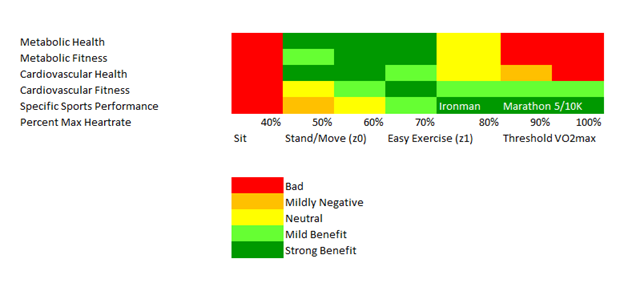How low is too low?
Why the easiest movement may be the most important for your health!
Ah, the eternal question…
Am I really getting any benefit from this? It just feels too easy to be beneficial.
Not to be pedantic, but I’m going to need you to define “benefit”
See, there are all kinds of ways that movement, in all its forms and intensities, is beneficial to us as humans. It can range from going faster in our local 5K, all the way to not dropping dead from a heart attack. Personally, while I like them both, big fan of the latter. Big fan 😊
So, let’s do that first. Let’s see if we can break the question of benefit into some popular broad categories of the various reasons that people might exercise….
1. Metabolic Health – i.e. maintaining insulin sensitivity, keeping our blood glucose within healthy ranges, avoiding Wilfotd Brimley knocking on our door to tell us about Diabeetus. A large part of this comes down to energy management, i.e. not taking in larger amounts of energy than we are making use of in movement and timing that movement to minimize the stress on the system.
2. Cardiovascular Health – closely linked to metabolic health, probably more so than most people realize. This category consists of avoiding the number one killer in the U.S. – heart disease (a catch-all term that comprises heart attacks, congestive heart failure and other arrhythmia issues) For the first two of these, in particular, a large part of avoiding them comes down to keeping our LDL cholesterol and ApoB within a healthy range and avoiding the consequent buildup of plaque deposits in our arteries that could ultimately rupture and block some pretty important blood vessels – like the coronary artery that gives your heart the oxygen it needs!
3. Metabolic Fitness – here we’re largely talking about having high levels of fat oxidation that can contribute to energy needs across a wide range of intensities. This has a very large impact on any sports event that is limited by glycogen depletion e.g. Ironman, marathon. Additionally, it has an underestimated impact on the training for events that are *not* energy limited e.g. 5K racing, 10K racing. Having the ability to not have to use precious glycogen for easy training, gives the athlete more glycogen stores that they can devote to the “hard” training. Finally, having the ability to burn large amounts of fat can be very helpful for maintaining a healthy bodyweight and strong metabolic health as well!
4. Cardiovascular Fitness – we’re largely talking about VO2max here and all if its major central components – i.e. having a large heart that can pump a lot of blood (and a lot of oxygen) with each beat & well-developed delivery systems – big compliant arteries and an abundant network of capillaries that can deliver that oxygen deep into the muscle close to the mitochondria – the energy factory of the cell.
5. Specific Sports Performance – different events have different demands. While there is always some overlap, some events will lean more heavily on certain muscle fiber types than others. This is shown in the differences in depletion patterns for different events. When it comes to endurance performance, paying more attention to training the muscle fibers that the event leans most heavily on is a prudent strategy in the lead-up to an event. Of course, beyond the physiology, this specific focus also allows for specific tactical preparation.
OK, so we know what we want. That’s big. A lot of athletes who are training primarily for health and fitness aren’t always really clear on what benefits they’re targeting, and knowing what benefits you’re targeting is important because different goals require different training and, furthermore, some types of training can actually have a negative impact on other goals! So, let’s look at this relationship between the different types of training intensity on the different goals listed above…
Figure: Fit for what? Different objectives require different intensities.
In the above chart we have the various objectives that we outlined above listed along with a scale from <40% max heart rate all the way to 100% max heart rate. Then the corresponding objective-intensity squares are color-coded from red meaning time spent at that intensity is inherently negative towards that objective all the way up to deep green, where time spent at that intensity is strongly beneficial to the goal. While the benefit or lack thereof is never absolute and always context dependent, I’ll explain my rationale for each below…
Keep reading with a 7-day free trial
Subscribe to The Science of Maximal Athletic Development to keep reading this post and get 7 days of free access to the full post archives.



